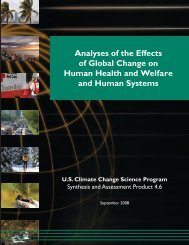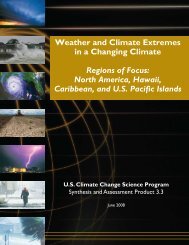Past Climate Variability and Change in the Arctic and at High Latitudes
Past Climate Variability and Change in the Arctic and at High Latitudes
Past Climate Variability and Change in the Arctic and at High Latitudes
You also want an ePaper? Increase the reach of your titles
YUMPU automatically turns print PDFs into web optimized ePapers that Google loves.
164<br />
The U.S. <strong>Clim<strong>at</strong>e</strong> Science Program<br />
These recent reductions<br />
<strong>in</strong> <strong>the</strong> extent <strong>and</strong><br />
thickness of ice cover<br />
<strong>and</strong> <strong>the</strong> projections<br />
for its fur<strong>the</strong>r<br />
shr<strong>in</strong>kage necessit<strong>at</strong>e<br />
a comprehensive<br />
<strong>in</strong>vestig<strong>at</strong>ion of <strong>the</strong><br />
longer term history<br />
of <strong>Arctic</strong> sea ice. To<br />
<strong>in</strong>terpret present<br />
changes we need to<br />
underst<strong>and</strong> <strong>the</strong> <strong>Arctic</strong>’s<br />
n<strong>at</strong>ural variability.<br />
The past distribution<br />
of sea ice is recorded<br />
<strong>in</strong> sediments preserved<br />
on <strong>the</strong> sea floor <strong>and</strong><br />
<strong>in</strong> deposits along many<br />
<strong>Arctic</strong> coasts.<br />
Although this trend argues th<strong>at</strong> n<strong>at</strong>ural variability<br />
has strongly contributed to <strong>the</strong> observed<br />
trend, Stroeve et al. (2006) concluded th<strong>at</strong>, as a<br />
group, <strong>the</strong> models underestim<strong>at</strong>e <strong>the</strong> sensitivity<br />
of sea ice cover to forc<strong>in</strong>g by greenhouse gases.<br />
Overly thick ice assumed by many of <strong>the</strong> models<br />
appears to provide <strong>at</strong> least a partial explan<strong>at</strong>ion.<br />
The Intergovernmental Panel on <strong>Clim<strong>at</strong>e</strong><br />
<strong>Change</strong> Fourth Assessment Report (IPCC-AR4)<br />
models driven with <strong>the</strong> SRES A1B emissions<br />
scenario (<strong>in</strong> which CO 2 reaches 720 parts per<br />
million (ppm), <strong>in</strong> comparison to <strong>the</strong> current<br />
value of 380 ppm, by <strong>the</strong> year 2100), po<strong>in</strong>t to<br />
complete or nearly complete loss (less than<br />
1×10 6 km 2) of September sea ice anywhere from<br />
year 2040 to well beyond <strong>the</strong> year 2100, depend<strong>in</strong>g<br />
on <strong>the</strong> model <strong>and</strong> particular run (ensemble<br />
member) for th<strong>at</strong> model. Even by <strong>the</strong> l<strong>at</strong>e 21st<br />
century, most models project a th<strong>in</strong> ice cover <strong>in</strong><br />
March (Serreze et al., 2007b). However, given<br />
<strong>the</strong> f<strong>in</strong>d<strong>in</strong>gs just discussed, <strong>the</strong> models as a<br />
group may be too conserv<strong>at</strong>ive—predict a l<strong>at</strong>er<br />
ra<strong>the</strong>r than earlier d<strong>at</strong>e—when <strong>the</strong> <strong>Arctic</strong> oceAn<br />
will be ice-free <strong>in</strong> summer.<br />
Abrupt change <strong>in</strong> future <strong>Arctic</strong> ice conditions<br />
is difficult to model. For <strong>in</strong>stance, <strong>the</strong> extent of<br />
end-of-summer ice is sensitive to ice thickness<br />
<strong>in</strong> spr<strong>in</strong>g (simul<strong>at</strong>ions based on <strong>the</strong> Community<br />
<strong>Clim<strong>at</strong>e</strong> System Model, version 3 (Holl<strong>and</strong> et al.,<br />
2006a)). If <strong>the</strong> ice is already th<strong>in</strong> <strong>in</strong> <strong>the</strong> spr<strong>in</strong>g,<br />
<strong>the</strong>n a “kick” associ<strong>at</strong>ed with n<strong>at</strong>ural clim<strong>at</strong>e<br />
variability might make it melt rapidly <strong>in</strong> <strong>the</strong><br />
summer ow<strong>in</strong>g to ice-albedo feedback. In <strong>the</strong><br />
Community <strong>Clim<strong>at</strong>e</strong> System Model, version<br />
3 events, anomalous ocean he<strong>at</strong> transport acts<br />
as this trigger. In one ensemble member, <strong>the</strong><br />
area of September ice decreases from about<br />
6×106 km 2 to 2×106 km 2 <strong>in</strong> 10 years, result<strong>in</strong>g<br />
<strong>in</strong> an essentially ice-free September by 2040.<br />
This result is not just an artifact of Community<br />
<strong>Clim<strong>at</strong>e</strong> System Model, version 3: a number of<br />
o<strong>the</strong>r clim<strong>at</strong>e models show similar rapid ice loss.<br />
These recent reductions <strong>in</strong> <strong>the</strong> extent <strong>and</strong> thickness<br />
of ice cover <strong>and</strong> <strong>the</strong> projections for its<br />
fur<strong>the</strong>r shr<strong>in</strong>kage necessit<strong>at</strong>e a comprehensive<br />
<strong>in</strong>vestig<strong>at</strong>ion of <strong>the</strong> longer term history of <strong>Arctic</strong><br />
sea ice. To <strong>in</strong>terpret present changes we need to<br />
underst<strong>and</strong> <strong>the</strong> <strong>Arctic</strong>’s n<strong>at</strong>ural variability. A<br />
special emphasis should be placed on <strong>the</strong> times<br />
of change such as <strong>the</strong> <strong>in</strong>iti<strong>at</strong>ion of seasonal<br />
<strong>and</strong> <strong>the</strong>n perennial ice <strong>and</strong> <strong>the</strong> periods of its<br />
l<strong>at</strong>er reductions.<br />
Chapter 6<br />
6.3 TYPES OF PALEOCLIMATE<br />
ARCHIVES AND PROXIES FOR<br />
THE SEA-ICE RECORD<br />
The past distribution of sea ice is recorded <strong>in</strong><br />
sediments preserved on <strong>the</strong> sea floor <strong>and</strong> <strong>in</strong><br />
deposits along many <strong>Arctic</strong> coasts. Indirect<br />
<strong>in</strong>form<strong>at</strong>ion on sea-ice extent can be derived<br />
from cores drilled <strong>in</strong> glaciers <strong>and</strong> ice sheets<br />
such as <strong>the</strong> GreenlAnd ice Sheet. Ice cores record<br />
<strong>at</strong>mospheric precipit<strong>at</strong>ion, which is l<strong>in</strong>ked<br />
with air-sea exchanges <strong>in</strong> surround<strong>in</strong>g oceanic<br />
areas. Such paleoclim<strong>at</strong>e <strong>in</strong>form<strong>at</strong>ion provides<br />
a context with<strong>in</strong> which <strong>the</strong> p<strong>at</strong>terns <strong>and</strong> effects<br />
of <strong>the</strong> current <strong>and</strong> future ice-reduced st<strong>at</strong>e of<br />
<strong>the</strong> <strong>Arctic</strong> can be evalu<strong>at</strong>ed.<br />
6.3.1 Mar<strong>in</strong>e Sedimentary Records<br />
The most complete <strong>and</strong> sp<strong>at</strong>ially extensive<br />
records of past sea ice are provided by sea-floor<br />
sediments from areas th<strong>at</strong> are or have been covered<br />
by flo<strong>at</strong><strong>in</strong>g ice. Sea ice affects deposition<br />
of such sediments directly or <strong>in</strong>directly through<br />
physical, chemical, <strong>and</strong> biological processes.<br />
These processes <strong>and</strong>, thus, ice characteristics<br />
can be reconstructed from a number of sediment<br />
proxies outl<strong>in</strong>ed below.<br />
Sediment cores th<strong>at</strong> represent <strong>the</strong> long-term history<br />
of sea ice embrac<strong>in</strong>g several million years<br />
are most likely to be found <strong>in</strong> <strong>the</strong> deep, central<br />
part of <strong>the</strong> <strong>Arctic</strong> oceAn where <strong>the</strong> sea floor was<br />
not eroded dur<strong>in</strong>g periods of lower sea-level (<strong>and</strong><br />
larger ice sheets). On <strong>the</strong> o<strong>the</strong>r h<strong>and</strong>, r<strong>at</strong>es of<br />
sediment deposition <strong>in</strong> <strong>the</strong> central <strong>Arctic</strong> oceAn<br />
are generally low, on <strong>the</strong> order of centimeters or<br />
even millimeters per thous<strong>and</strong> years (Backman<br />
et al., 2004; Darby et al., 2006), so th<strong>at</strong> sedimentary<br />
records from <strong>the</strong>se areas may not capture<br />
short-term vari<strong>at</strong>ions <strong>in</strong> paleoenvironments. In<br />
contrast, cores from <strong>Arctic</strong> cont<strong>in</strong>ental marg<strong>in</strong>s<br />
usually represent a much shorter time <strong>in</strong>terval,<br />
less than 20 thous<strong>and</strong> years (k.y.) s<strong>in</strong>ce <strong>the</strong> Last<br />
Glacial Maximum, but <strong>the</strong>y sometimes provide<br />
high-resolution records th<strong>at</strong> capture events on<br />
century or even decadal time scales. Therefore,<br />
<strong>in</strong>vestig<strong>at</strong>ors need sediment cores from both<br />
<strong>the</strong> central bas<strong>in</strong> <strong>and</strong> cont<strong>in</strong>ental marg<strong>in</strong>s of <strong>the</strong><br />
<strong>Arctic</strong> oceAn to fully characterize sea-ice history<br />
<strong>and</strong> its rel<strong>at</strong>ion to clim<strong>at</strong>e change.




